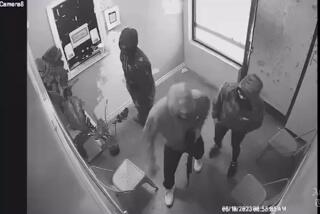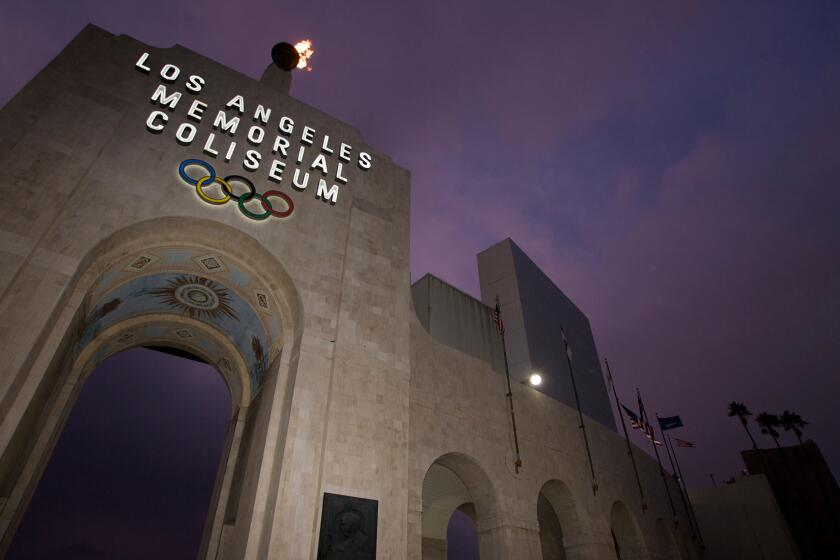Stings Bring War on Drugs to the Streets
NORTH HILLS — It looked like business as usual to unsuspecting neighbors: rough men in oversize pants and baggy shirts selling rocks of cocaine for $10 and $20.
But on this day, the curbside drug market was being run not by street thugs but undercover police. Drug shoppers arriving in sports cars, family vans and on bicycle were sold crushed macadamia nuts and then arrested by a swarm of officers hiding nearby.
The sting operation reflects one of the goals of President Clinton’s revamped drug enforcement policy: more aggressive local policing to curb drug dealing in residential neighborhoods.
The rationale is simple. “If you don’t have the consumers, you won’t have the demand,” said Lt. Bernie Larralde of the Los Angeles Police Department’s narcotics division.
By focusing on rock cocaine users, police are also attempting to affect public health. A recent report showed that emergency room admissions for cocaine abuse in the county soared to record highs in the 1990s, mostly due to the drug’s availability on city streets.
But some judges, lawyers, academics and community activists question sting operations, saying they burden an already overcrowded criminal-justice system.
“There are solutions other than setting up people who want to buy small amounts of drugs,” said Bobbie Stein, who teaches at San Francisco’s New College of Law.
Although most first-time offenders will go free after completing 20 court-ordered drug education classes, Stein said, “there’s enough crime out there that the police don’t need to manufacture it themselves.”
Critics say police should focus on suppliers, not small-time buyers. Others complain that sting operations simply move the commerce from one neighborhood to another. And some question the justice of seeking felony charges--which can result in a year or more in prison--for buying a handful of nuts.
But neighbors in this crime-plagued north San Fernando Valley neighborhood say they support any reasonable effort to clear the sidewalks of drug dealers and their customers.
“You see young men, four and five at a time, stopping cars. It’s incredible, it’s disgusting,” said Ivelise Markovits, the executive director of Penny Lane, a North Hills school and dormitory for teenage girls with emotional problems.
Even some of the drug buyers say their arrests may be a blessing in disguise, triggering liberation from the grip of crack cocaine addiction.
“It changed me in a major way,” said a 35-year-old stockbroker who was arrested in a sting last year. “I’m a drug user and I did not want to face that. But when I was arrested . . . the reality scared me straight.”
In the recent North Hills operation, youthful-looking undercover officers sold the chopped nuts wrapped in plastic to 26 people, all of whom face felony charges of attempting to possess a controlled substance.
Officer Mario Rivas gave a well-rehearsed pitch in the sting. “Whatcha need? Rock or powder?” he asked a prospective customer outside a North Hills apartment building on Orion Avenue near Nordhoff Street.
Officer Melissa Town was in a nearby apartment, listening to the transaction by wireless radio. Between sips of a Starbucks latte and bites of a granola bar, she reported into her radio: “It’s a go, it’s a go, it’s a go.” Seconds later, police in black-and-white chase units drove out from behind the apartment complex, tires squealing.
“It’s a game,” Rivas said later. He dresses in baggy jeans, sunglasses and silver earrings for his role. “You just have to know how to play.”
During a nearby sting operation the following week, neighbors acknowledged the police efforts as they ushered handcuffed customers into vans headed for jail.
“You guys should be out here every night,” said Michael Housepian, an electrician. “Enough is enough.”
But as soon as the police fold up their undercover operation, the market reopens for business.
The next day, drug dealers brazenly approached cars and pedestrians with a lawlessness police eventually hope to break--in part with a sting operations, where police pose as sellers.
The LAPD’s recent use of macadamia nuts as bait--and the department’s insistence that buyers be charged with felonies--has come under scrutiny from prosecutors and judges.
Deputy Dist. Atty. Stephen Cooley, who oversees the San Fernando branch of the Los Angeles County district attorney’s office, has requested a legal opinion to ensure the legality of filing felony charges against people who, in effect, are buying food disguised as cocaine.
The district attorney’s appellate division believes the cases are indeed felonies--rather than misdemeanors--because suspects were attempting to purchase illegal drugs, the law’s only requirement. The buyers came to the area, money in hand, to buy crack cocaine, Cooley said.
“I think it’s an investigative technique that sounds a little weird--these people are buying macadamia nuts, after all--but I think it’s valid.”
During their North Hills sting operation, officers arrested a cross-section of city residents--women, men, blacks, Latinos, whites, a construction worker, a cocktail hostess and an unemployed couple. One customer was a middle-aged man in a car that sported the bumper sticker: “Jesus is the answer.”
A detective arrested the ex-wife of his neighbor, a couple he has known for years from a suburb miles away. While he was reading the woman her rights as she was handcuffed, she looked directly into his eyes but, he said, she didn’t recognize him.
Most of the buyers, in fact, were so intent on buying cocaine, they never noticed the uniformed officers standing in a nearby apartment window, or the black-and-white patrol cars turning into a driveway.
After one arrest, Rivas returned to his spot outside the building and immediately greeted another prospective buyer.
This time, a 45-year-old Woodland Hills real estate agent took the bait.
“It can be people with good jobs and families. It can be your next-door neighbor,” said Lt. Bob Warren, who oversees the Valley narcotics group. “They’re all coming to one of the worst drug areas in the city to buy drugs from apparent gang members. The impetus must be incredibly strong.”
In fact, many people caught in drug stings say they gave no thought to the possibility of arrest--only about the intense high of crack cocaine.
Crack, which got its name from the sound the drug makes as it burns, is a highly addictive form of cocaine. It is smoked through a pipe, and the effect is immediate. When users are under the influence of the drug--which lasts about 15 minutes--they say they can think only of getting more.
The addiction is so strong that some sting victims later admitted that they view their arrest as a last chance to finally quit.
“Drugs are never going to come into my life again,” said Jeff, a 46-year-old Reseda resident attending a drug education class after being arrested in a Northridge sting last year. “That night was the end of it.”
Said 33-year-old Pattie Torre, a mother of six who was arrested in Reseda: “I’m glad I got arrested. It gave me a new way of living.”
Police arrests finally prompted Theresa Majidzadeh, a former bartender and drug dealer, to change her life. She now runs the drug diversion program at the Van Nuys Inter-Agency Drug Abuse Recovery Programs. She was arrested twice--once for carrying a virtual drugstore in her purse, including cocaine, LSD and marijuana.
“It was the end,” Majidzadeh said. “I had tried to get clean on my own, but just couldn’t. And without a [drug recovery] program, I never would have.”
Since rock cocaine became widely available in Los Angeles in the mid-1980s, police and others say there has been no shortage of customers or sellers.
In the first few months of this year, LAPD narcotics arrests are up 7%--6,006 compared to 5,601 a year ago. While statistics are not broken down by drug type, police say crack cocaine accounts for most of the drug-related arrests.
In North Hills, police made 276 narcotics arrests in the first quarter of the year, a 119% increase over the same period last year.
Mark Kleiman, an associate professor of public policy at Harvard University’s Kennedy School of Government and an expert on illegal drug markets, said undercover stings must be viewed as only one part of an overall strategy.
“Taking a few dealers off the street, taking a few buyers off the street does no good unless you really put the word out that if you buy crack in our neighborhood, you could be buying from a police officer,” Kleiman said.
As proof, police point to decreases in the number of drug arrests in the Northridge neighborhood near Tampa and Parthenia avenues. Though it was once a hotbed of drug dealing, police say they have made 19 narcotics-related arrests there in the first few months of the year, compared to more than 100 arrests during the same period last year.
Officers say a combination of sting operations and increased patrols drove away dealers and buyers.
“The word got out,” said Warren of the Valley narcotics unit in Van Nuys. “My guess is that the same thing will happen” in North Hills.
Although critics say the stings only scatter buyers and sellers to other neighborhoods, police argue that neighbors welcome any relief, even if temporary.
“We’re not naive enough to think that street-level dealing will disappear with a couple of undercover sting operations,” said Det. Larry Broadhurst, who works for the LAPD’s narcotics division downtown.
“But at the least, we need to keep these people on their toes and keep moving. We’ve got to keep them on the run and eventually convince them they have to get out of the business.”
More to Read
Sign up for Essential California
The most important California stories and recommendations in your inbox every morning.
You may occasionally receive promotional content from the Los Angeles Times.










